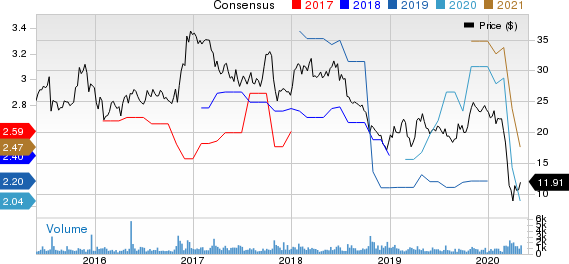Royal Bank of Canada (RY) Q2 Earnings Disappoint, Provisions Up
Royal Bank of Canada RY reported second-quarter fiscal 2020 (ended Apr 30, 2020) net income of C$1.5 billion ($1.09 billion), significantly down 54% from the prior-year quarter’s reported tally.
The bank witnessed lower revenues, along with escalating expenses and provisions. However, elevated loans and deposit balances were on the positive side, boosting investors’ optimism, which caused its shares to rise 3.9% on the NYSE, following the results.
Furthermore, on a year-over-year basis, Wealth Management, Personal & Commercial Banking, Capital Markets, Corporate Support and Canadian Banking reported a decline of 28%, 66%, 86%, 6.7% and 55.5%, respectively, in the quarterly net income. Nevertheless, net income in the Investor & Treasury Services and Insurance segments surged 50% and 17%, respectively.
Revenues Down, Expenses & Provisions Escalate
Total revenues came in at C$10.3 billion ($7.5 billion) during the February-April quarter, down 10.4% on a year-over-year basis. Revenues were adversely impacted by lower non-interest income, partly offset by higher net interest income.
Net interest income came in at C$5.5 billion ($4 billion), up 14.6% from the prior-year quarter. Non-interest income was C$4.9 billion ($3.6 billion), down 26.9% year over year.
Non-interest expenses came in at C$5.9 billion ($4.3 billion), marginally up from the year-ago quarter. This upswing primarily resulted from rise in almost all the components, partly muted by lower human resources and communications costs.
As of Apr 30, 2020, Royal Bank of Canada’s total loans came in at C$673.8 billion ($482.9 billion), up 4.6% from the prior quarter. Additionally, deposits totaled C$1.01 trillion ($0.72 trillion), up 11.8% sequentially. Total assets were C$1.68 trillion ($1.2 trillion), up 13.5% from the previous quarter.
Total provision for credit losses was C$2.83 billion ($2.06 billion) in the quarter, surging significantly year over year, mainly due to coronavirus concerns.
Solid Capital Position
As of Apr 30, 2020, Royal Bank of Canada’s Tier 1 capital ratio came in at 12.7%, down from the prior-year quarter’s 12.9%. Total capital ratio came in at 14.6%, down from the 14.8% reported in the year-earlier quarter.
The company’s estimated Common Equity Tier 1 (CET1) ratio came in at 11.7%, contracting 10 basis points from the prior-year quarter.
Our Viewpoint
We believe a continued improvement in loan balances and a diversified product mix will drive Royal Bank of Canada’s organic growth. Though stringent regulatory reforms, along with escalating expenses and provisions, keep us skeptical about the company’s sustainable growth over the long term, Canada’s export-driven economy is anticipated to gain from the recovery of the U.S. economy hit by the coronavirus-related mayhem, thereby benefiting the bank.
Royal Bank Of Canada Price, Consensus and EPS Surprise

Royal Bank Of Canada price-consensus-eps-surprise-chart | Royal Bank Of Canada Quote
Royal Bank of Canada currently carries a Zacks Rank #3 (Hold). You can see the complete list of today’s Zacks #1 Rank (Strong Buy) stocks here.
Performance of Other Banks
Bank of Montreal’s BMO second-quarter fiscal 2020 (ended Apr 30) adjusted net income was C$715 million ($519.9 billion), down 53% year over year. The results were hurt by lower revenues and a significant rise in credit costs.
The Bank of Nova Scotia BNS reported second-quarter fiscal 2020 (ended Apr 30) adjusted net income of C$1.4 billion ($1 billion), down 39% year over year. Results excluded certain one-time items.
Eaton Vance Corp.’s EV second-quarter fiscal 2020 (ended Apr 30) adjusted earnings of 80 cents per share surpassed the Zacks Consensus Estimate of 71 cents. Including certain one-time items, earnings came in at 65 cents, down 27% year on year.
The Hottest Tech Mega-Trend of All
Last year, it generated $24 billion in global revenues. By 2020, it's predicted to blast through the roof to $77.6 billion. Famed investor Mark Cuban says it will produce "the world's first trillionaires," but that should still leave plenty of money for regular investors who make the right trades early.
See Zacks' 3 Best Stocks to Play This Trend >>
Want the latest recommendations from Zacks Investment Research? Today, you can download 7 Best Stocks for the Next 30 Days. Click to get this free report
Bank of Nova Scotia The (BNS) : Free Stock Analysis Report
Bank Of Montreal (BMO) : Free Stock Analysis Report
Eaton Vance Corporation (EV) : Free Stock Analysis Report
Royal Bank Of Canada (RY) : Free Stock Analysis Report
To read this article on Zacks.com click here.
Zacks Investment Research

 Yahoo Finance
Yahoo Finance 